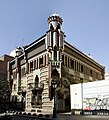
Casa Batlló is a building in the center of Barcelona, Spain. It was designed by Antoni Gaudí, and is considered one of his masterpieces. A remodel of a previously built house, it was redesigned in 1904 by Gaudí and has been refurbished several times. Gaudí's assistants Domènec Sugrañes i Gras, Josep Canaleta and Joan Rubió also contributed to the renovation project.
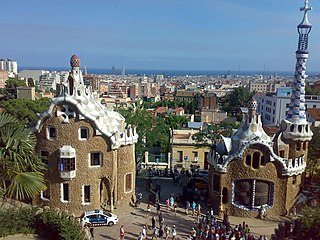
Park Güell is a privatized park system composed of gardens and architectural elements located on Turó del Carmel, in Barcelona, Catalonia, Spain. Turó del Carmel belongs to the mountain range of Collserola – the Parc del Carmel is located on the northern face. Park Güell is located in La Salut, a neighborhood in the Gràcia district of Barcelona. With urbanization in mind, Eusebi Güell assigned the design of the park to Antoni Gaudí, a renowned architect and the face of Catalan modernism.
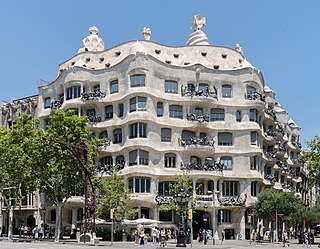
Casa Milà, popularly known as La Pedrera in reference to its unconventional rough-hewn appearance, is a Modernista building in Barcelona, Catalonia, Spain. It was the last private residence designed by architect Antoni Gaudí and was built between 1906 and 1912.

The Basílica i Temple Expiatori de la Sagrada Família, otherwise known as Sagrada Família, is a church under construction in the Eixample district of Barcelona, Catalonia, Spain. It is the largest unfinished Catholic church in the world. Designed by Catalan architect Antoni Gaudí (1852–1926), in 2005 his work on Sagrada Família was added to an existing (1984) UNESCO World Heritage Site, "Works of Antoni Gaudí". On 7 November 2010, Pope Benedict XVI consecrated the church and proclaimed it a minor basilica.

The Eixample is a district of Barcelona between the old city and what were once surrounding small towns, constructed in the 19th and early 20th centuries. Its population was 262,000 at the last census (2005).

A Gesamtkunstwerk is a work of art that makes use of all or many art forms or strives to do so. The term is a German loanword accepted in English as a term in aesthetics.

Modernisme, also known as Catalan modernism and Catalan art nouveau, is the historiographic denomination given to an art and literature movement associated with the search of a new entitlement of Catalan culture, one of the most predominant cultures within Spain. Nowadays, it is considered a movement based on the cultural revindication of a Catalan identity. Its main form of expression was Modernista architecture, but it also encompassed many other arts, such as painting and sculpture, and especially the design and the decorative arts, which were particularly important, especially in their role as support to architecture. Modernisme was also a literary movement.

Casa Vicens is a modernist building situated in the Gràcia neighbourhood of Barcelona. It is the work of architect Antoni Gaudí and is considered to be his first major project. It was built between 1883 and 1885, although Gaudí drew up the initial plans between 1878 and 1880. The work belongs to the orientalist style, similar to Neo-Mudéjar architecture, although interpreted in Gaudí’s own personal way, with a uniqueness that only he knew how to add to his projects. In this work, and for the first time, Gaudí outlined some of his constructive resources that would become regular features throughout the emergence of Modernisme. The work was widely discussed when it was built and caused a great sensation among the general public at the time. When the building was constructed, Gràcia was still an independent urban nucleus of Barcelona; it had its own council and was classified as a town, though nowadays it is a district of the city.
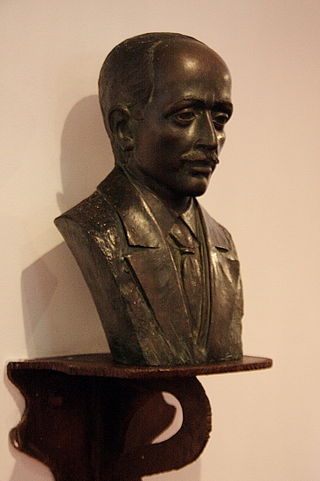
José María Jujol Gibert was a Catalan Spanish architect. Jujol's wide field of activity ranged from furniture designs and painting, to architecture. He worked with Antoni Gaudí on many of his most famous works. Among Jujol's projects are Casa Batlló, Casa Milà, Park Güell, and Our Lady of Montserrat, and among his design styles are Modernisme and Art Nouveau.

The Church of Colònia Güell is an unfinished work by Antoni Gaudí. It was built as a place of worship for the people on a hillside in a manufacturing area in Santa Coloma de Cervelló, near Barcelona. Colònia Güell was the brainchild of Count Eusebi de Güell; who enlisted the help of architect Antoni Gaudí in 1898. However, work was not started until 1908, 10 years after commission. The plan for the building consisted of constructing two naves, an upper and a lower, two towers, and one forty-meter-high central dome. In 1914, the Güell family halted construction due to the death of Count Güell. At the time, the lower nave was almost complete so between the years of 1915 and 1917, it was completed and readied for use.

Barcelona'sculture stems from the city's 2000 years of history. Barcelona has historically been a cultural center of reference in the world. To a greater extent than the rest of Catalonia, where Catalonia's native language Catalan is more dominant, Barcelona is a bilingual city: Catalan and Spanish are both official and widely spoken. Since the arrival of democracy, the Catalan culture has experienced a rebirth, both by recovering works from the past and by stimulating the creation of new works. Barcelona is an international hub of highly active and diverse cultural life with theatres, concert halls, cinemas, museums, and high-value architectural heritage.
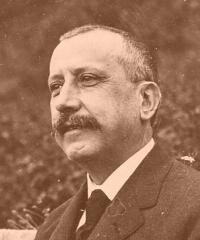
Joan Rubió y Bellver was a Spanish architect famous for his contributions to the Catalan Modernista movement.
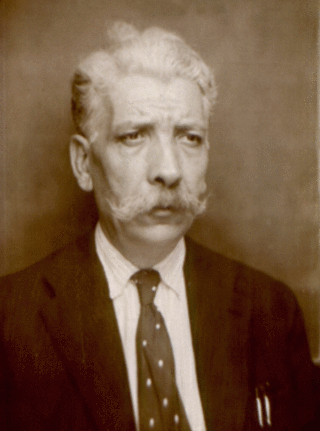
Domènec Sugrañes i Gras was a Catalan modernist architect and disciple of Antoni Gaudí. He succeeded him at the head of the works of the church of the Sagrada Família and finished the façade of the Nativity. Sugrañes held this charge during 10 years, from Gaudí's death in 1926 until 20 July 1936.
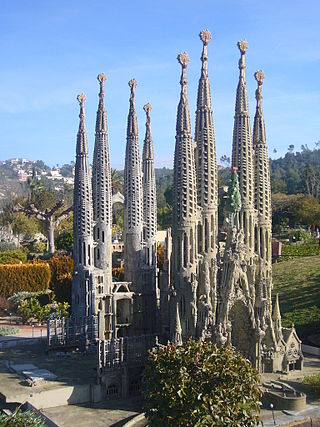
Catalunya en Miniatura is a miniature park inaugurated in 1983 in Torrelles de Llobregat, 17 km (11 mi) from Barcelona. The park is 60,000 m2 (650,000 sq ft), 35,000 m2 (380,000 sq ft) of them devoted to the scale models, it is one of the largest miniature parks in the world, and the largest of the 14 miniature building exhibitions present in Europe. It displays 147 models of palaces, churches, bridges and other buildings from Catalonia and Mallorca and it includes all the major works by the renowned architect Antoni Gaudí.

Antoni Gaudí i Cornet was a Spanish architect and designer from Catalonia, known as the greatest exponent of Catalan Modernism. Gaudí's works have a sui generis style. Most are located in Barcelona, including his main work, the Sagrada Família church.

The Gaudí House Museum, located within the Park Güell in Barcelona, is a historic home museum that houses a collection of furniture and objects designed by the Spanish architect Antoni Gaudí. It was the residence of Gaudí for almost 20 years, from 1906 until the end of 1925. On 28 September 1963 it opened as a historic home museum.
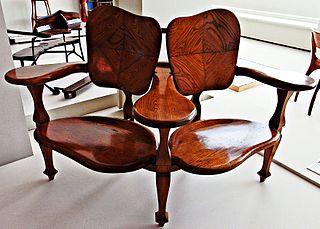
The Confidant from Casa Batlló, also known as the Double Sofa or Banc de dues places , is a furniture piece designed by Antoni Gaudí. Originally designed for the dining room of Casa Batlló on Barcelona's Passeig de Gràcia, the chair is currently exhibited in the Modern Art collection of the Museu Nacional d'Art de Catalunya and at Gaudí House Museum in Barcelona. Replicas are displayed at the Gaudí-designed Casa Batlló and Casa Milà.

The banner of Misericordia (Mercy) is a work of the Catalan architect Antoni Gaudí projected for the procession to the Sanctuary of Misericordia in Reus of the reusians residing in Barcelona as one of the acts for the 1900 Holy Year. It is known by the two front and back photographs published in the Semanario Católico de Reus in July of that year. It included another photograph of the procession in which Gaudí is seen as part of a large group of pilgrims and the banner being carried by one of them.
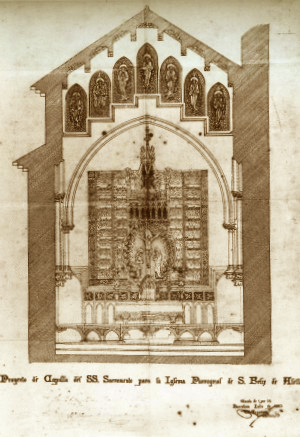
The Altarpiece of Alella is an altarpiece by the Catalan architect Antoni Gaudí that is part of the project of the chapel of the Holy Sacrament commissioned in 1883 by the Rector Jaume Puig i Claret for the parish church of Sant Feliu in Alella. It became known by a drawing preserved in the parochial archive found in 1959, delineated with India ink in two colours and showing Gaudí's signature, published for the first time in the same year. A reproduction was included the book Gaudí by George R. Collins the following year which was transcendent for the worldwide diffusion of the work of the architect of Reus as it was the first monograph dedicated to him in English language.

The following outline is provided as an overview of and topical guide to Barcelona:























